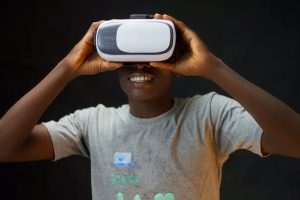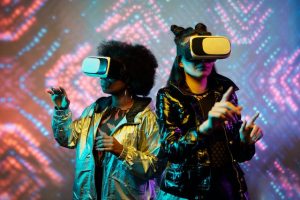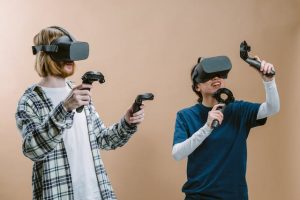Even though being able to step into your future office building before a single brick is laid or try on clothes from your favourite store without leaving your couch may sound like something from the future, it’s actually far closer than you may think.
Such opportunities are rapidly becoming a reality for businesses and consumers alike, thanks to virtual and augmented reality in different business fields.
VR and AR technologies are not only revolutionizing the way companies interact with customers, but they’re also contributing significantly to the product designing process, as well as staff onboarding and training.
So, let’s delve deep into the dynamic ways these cutting-edge technologies are reshaping various industry sectors, and see what’s going on in the ultra-modern world of business operation and consumer engagement.
Changes in the Retail Industry

The retail industry is one among many that are witnessing a dramatic transformation thanks to the immersive experiences that VR and AR offer. With VR, customers can immerse themselves in a real-life shopping environment without ever having to actually visit a brick-and-mortar store.
Similarly, AR apps allow customers to more easily visualize products in their real-world environment or even on themselves. Not only does this help enhance customer experience but it also significantly reduces the hesitation associated with online purchases. Needless to say, this also leads to lower return rates.
On the other side of things, VR and AR greatly contribute to inventory management and space planning as well. What this means is that retailers that decide to use these technologies will have an easier time visualizing store layouts before actually making any physical changes, which – of course – saves both time and money.
Immersive technologies are also excellent at offering valuable data about customer interactions and preferences. Not only can these influence stock placement and personalized marketing campaigns, but they also make room for data-driven retail strategy.
Shifts in the Real Estate Industry

In the world of real estate, being able to actually visualize yourself in the space you’re considering is everything, and this is where arguably AR and VR shine the brightest. These technologies allow potential buyers to tour properties whenever and wherever they feel like it.
Since there are no physical barriers, such as scheduling open house visits, AR and VR tours offer 24/7 viewing opportunities. Detailed virtual tours can easily vividly showcase every aspect of a property, which makes the whole experience more efficient – both time and logistic-wise.
With the help of AR technologies, viewers can easily play around with different floor plans and layouts, while VR offers the opportunity to showcase a property’s maximum potential without heavy monetary investment.
Another perk worth mentioning is that thanks to AR and VR, international investors can now also explore properties from afar, which significantly expands the market reach and facilitates global investment opportunities.
Immersive Consumer Insights Help Enrich Market Research

Any business that’s hoping to reach any type of success must first ensure that they get a good grasp on customer behaviour. Only then can the business ensure that it offers products and services that will resonate properly with its target market.
Thanks to VR, businesses can nowadays easily simulate shopping experiences, test new store layouts, or assess reactions to product placements, based on previously gathered data. Not only does this provide the business with valuable consumer insights with little to no risk, but it also enables it to tailor their offerings to resonate better with its customer’s preferences and behaviours.
Redefining Corporate Training and Development

Forget the days of dull training videos and hefty manuals, as AR and VR have introduced a novel approach to employee training and education. These technologies enable the simulation of real job situations for a hands-on learning experience without any of the risks associated with on-the-job training.
For example, this is particularly useful in the medical field. Medical professionals can practice complex procedures in a controlled, virtual environment, without posing any serious risk. Similarly, mechanics can disassemble engines and explore their components without getting so much as a spec of grease on their hands.
Final Thoughts
Businesses that choose to rely on AR and VR technologies are entering a new phase of operational efficiency and customer engagement. It’s important to understand that these technologies are not just changes; Instead, they represent a significant improvement in how industries operate and connect with their market, which is why it comes as no surprise that understanding and harnessing these technologies means the world of difference when it comes to the survival and prosperity of businesses.
Author Profile

- Content writer and WordPress website developer. I also love to create content on YouTube and other social platforms as well as promotional and social marketing.
Latest entries
 Business AdviceAugust 29, 2024How can managed IT Services make your Business more efficient?
Business AdviceAugust 29, 2024How can managed IT Services make your Business more efficient? BusinessJune 5, 20248 Expert Hacks to Optimise Your Website for Maximum Lead Generation
BusinessJune 5, 20248 Expert Hacks to Optimise Your Website for Maximum Lead Generation Must Read NewsMarch 14, 2024Top 7 Trending Software Development Technologies in 2024
Must Read NewsMarch 14, 2024Top 7 Trending Software Development Technologies in 2024 Must Read NewsFebruary 28, 2024Top 8 Cybersecurity Tools For Mobile Devices
Must Read NewsFebruary 28, 2024Top 8 Cybersecurity Tools For Mobile Devices




